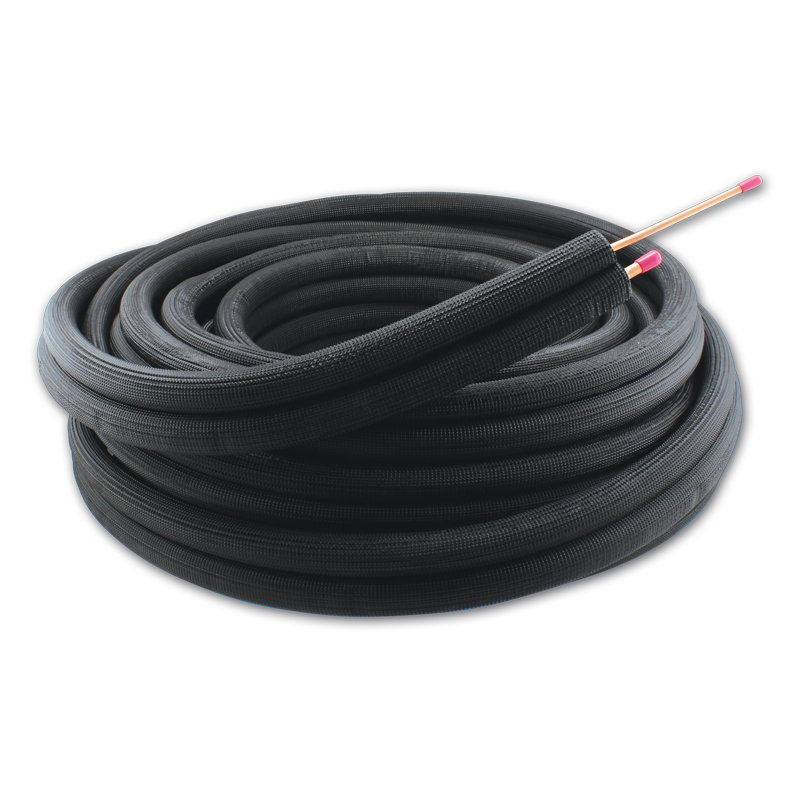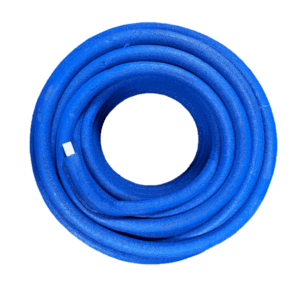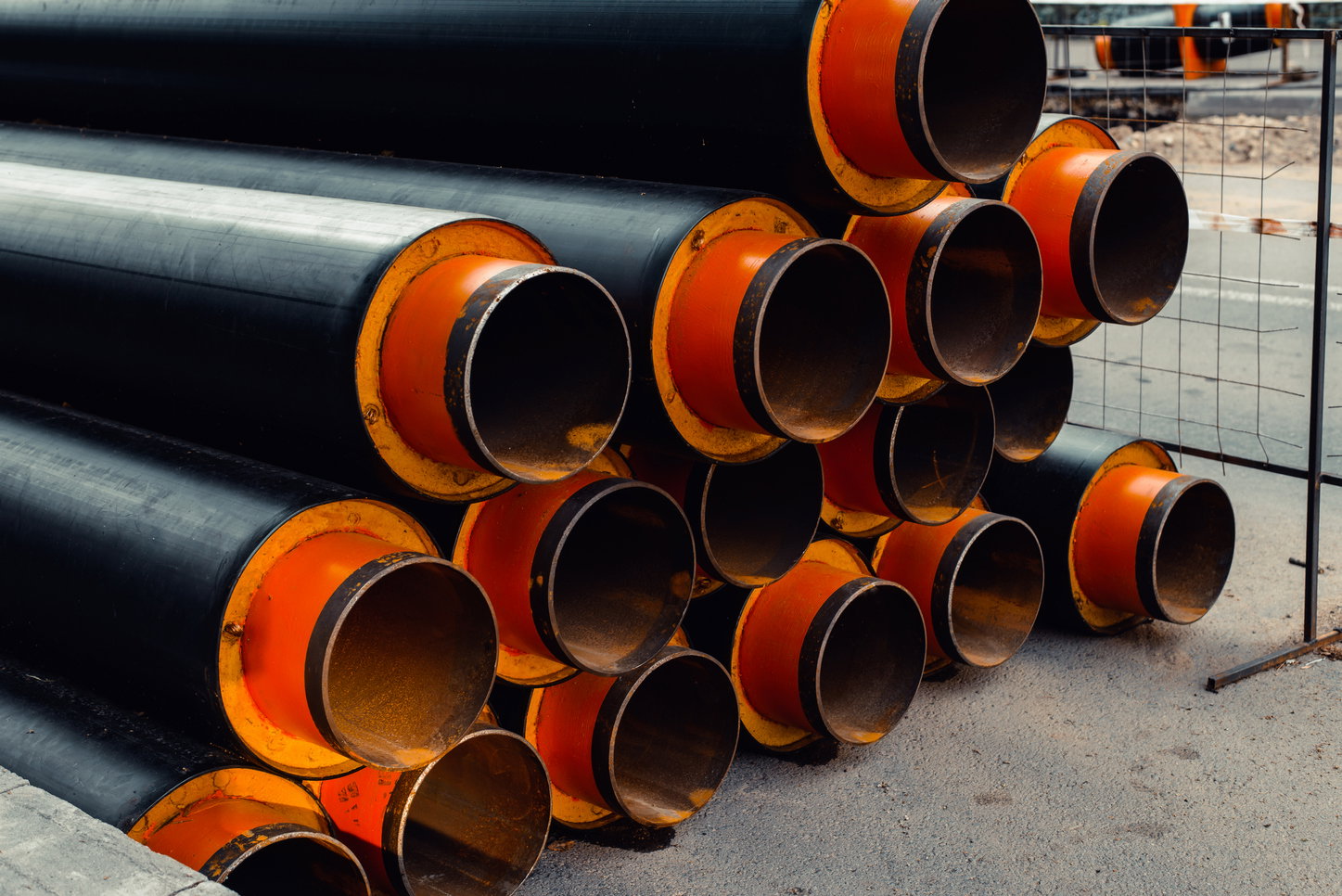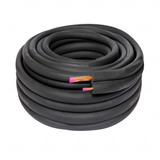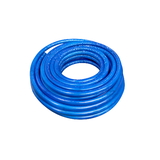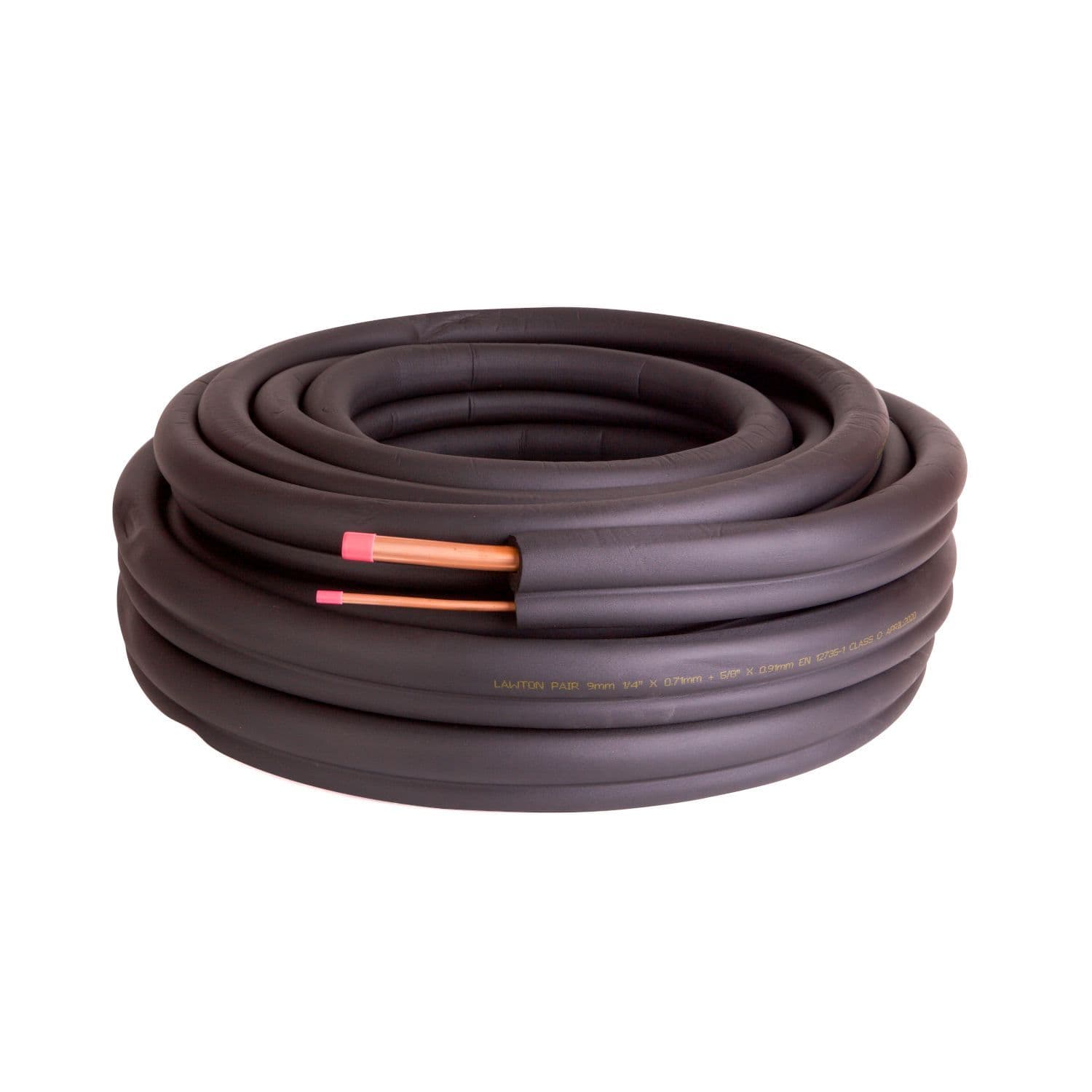- Blogs
- Pre-Insulated Pipes: A Comprehensive Guide and Where To Buy
Pre-Insulated Pipes: A Comprehensive Guide and Where To Buy
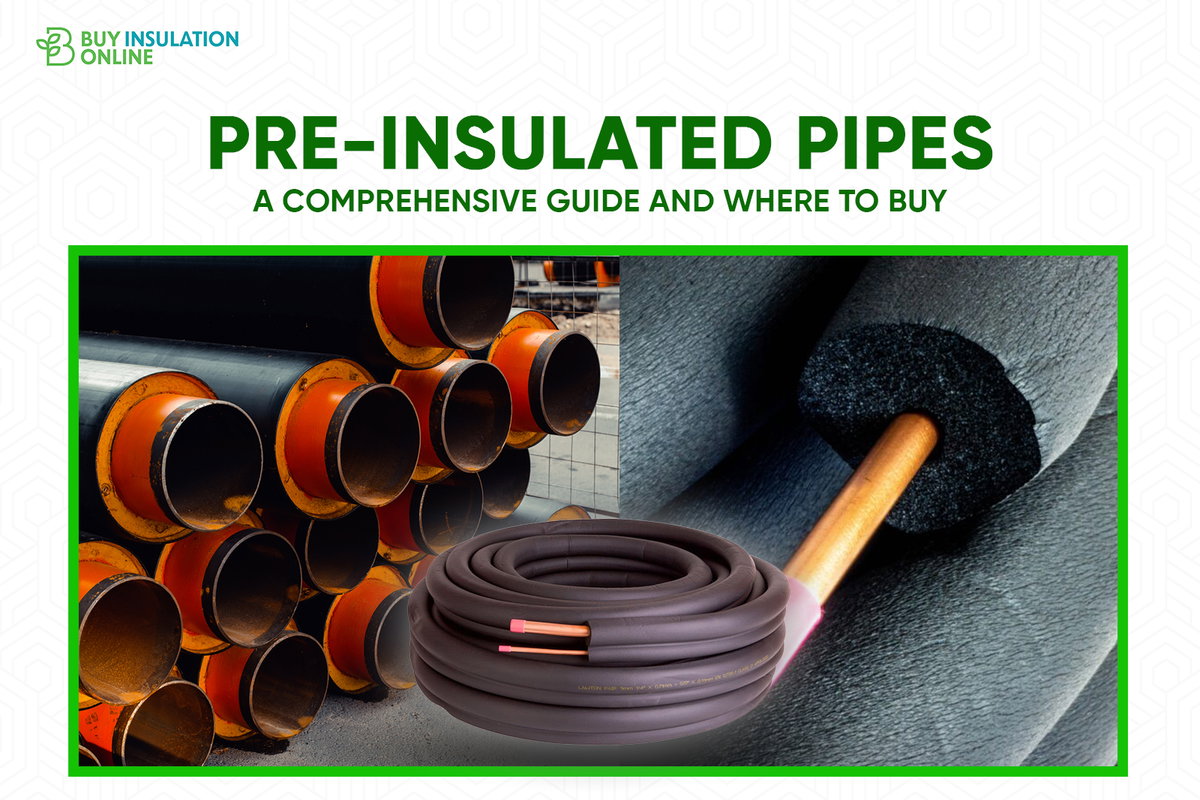
Preinsulated pipework has emerged as a sophisticated and increasingly vital solution for the efficient and reliable transport of fluids across a multitude of applications within the building services and infrastructure sectors.
This advanced piping system is engineered as a comprehensive assembly, comprising a central carrier pipe responsible for conveying the fluid, a carefully selected layer of thermal insulation designed to minimise energy loss or gain, and a robust outer protective jacket that shields both the insulation and the carrier pipe from the detrimental effects of environmental factors and potential physical damage.
The growing significance of pre-insulated pipework in contemporary construction and infrastructure projects is directly attributable to the escalating demands for enhanced energy efficiency, improved sustainability, and the imperative for streamlined installation processes that ultimately lead to reductions in project timelines and overall costs.
Pre-insulated pipework is an efficient and durable solution for transporting fluids internally and externally in the UK, offering energy savings, faster installation, and reduced maintenance.
It consists of a carrier pipe (steel, copper, or plastic), insulation (often polyurethane foam), and a protective jacket (typically polyethylene or steel).
Proper installation and adherence to UK standards and regulations (like BS EN 15632 and Building Regulations Part L) are crucial for optimal performance in applications such as district heating, industrial processes, and domestic water systems.
The inherent advantages of pre-insulated pipework extend to both internal and external applications.
Within buildings, for systems such as heating, ventilation, and air conditioning (HVAC), as well as domestic hot and cold water distribution, these pipes play a crucial role in maintaining the desired fluid temperatures, thereby reducing energy consumption and effectively preventing condensation on cold water lines.
In external environments, including district heating and cooling networks, underground water and utility services, and extensive industrial pipelines, pre-insulated pipework provides the essential benefit of minimizing thermal losses or gains over considerable distances.
Furthermore, the protective outer jacket offers critical defense against a wide array of environmental stressors, including moisture, ultraviolet (UV) radiation, and the pressures exerted by ground movement.
The adaptability and versatility of pre-insulated pipework are noteworthy, making it a suitable choice for an extensive range of industries and project scales, from individual residential dwellings to expansive industrial complexes and large-scale district energy distribution networks.
The increasing adoption of this technology reflects a fundamental shift within the construction and building services industries towards embracing prefabricated, high-performance solutions that directly address the critical challenges of energy efficiency and environmental responsibility.
This trend is not merely a matter of preference but has become a necessity, driven by increasingly stringent regulatory frameworks and the pressing need to minimize operational expenditures and reduce carbon footprints.
Materials Used in Pre Insulated Pipework ![]()
The effectiveness and longevity of preinsulated pipework are intrinsically linked to the quality and properties of the materials used in its construction.
These systems typically comprise three key components: the carrier pipe, the insulation layer, and the outer protective jacket.
The Inner Core: Carrier Pipe Materials
The carrier pipe, being the conduit for the fluid being transported, is selected based on the specific demands of the application, considering factors such as operating temperature, pressure, and the chemical nature of the fluid.
Common materials include steel, copper, and various types of plastic.
Preinsulated Steel Pipes
Steel stands out as a frequently chosen material for the carrier pipe due to its inherent high strength and durability.
This makes it exceptionally well-suited for applications that involve high pressures and elevated temperatures, such as those encountered in industrial processes and the primary distribution lines of district heating networks.
Within the realm of steel pipes, both seamless and welded options are available.
Seamless steel pipes are known for their structural integrity under pressure, while welded steel pipes often present a more economical solution for certain less demanding applications.
Stainless steel offers the significant advantage of superior resistance to corrosion, alongside maintaining excellent performance under high pressure, rendering it ideal for demanding environments and the transport of critical fluids where purity and longevity are paramount.
In specific scenarios where enhanced protection against rust and corrosion is required, galvanized steel, with its protective layer of zinc coating, may be employed to extend the operational lifespan of the pipework in potentially aggressive environments.
The continued prominence of steel in this role underscores its exceptional mechanical properties, providing a robust and reliable solution for a wide array of challenging applications, particularly those involving extreme operating conditions where strength and durability are non-negotiable.
Copper is another important material used for carrier pipes, particularly valued for its outstanding thermal conductivity, which facilitates highly efficient heat transfer.
Its good temperature tolerance also makes it a preferred choice for applications where rapid heating or cooling of the conveyed fluid is required, such as in certain domestic hot water systems and AC applications.
While copper exhibits excellent thermal properties, it is generally considered less suitable for extremely high-pressure applications compared to steel due to its comparatively lower mechanical strength.
For ease of installation, especially in confined spaces or complex layouts, soft copper options are available, offering increased flexibility.
Pre Insulated Copper Pipes
Copper's niche as a carrier pipe material lies in its superior ability to conduct heat, making it the material of choice for systems where efficient thermal exchange such as Aircon systems, is a primary design consideration, often outweighing the need for ultra-high pressure resistance.
Plastic Preinsulated Pipes
The use of various plastic materials for carrier pipes has seen a significant increase due to their inherent advantages.
These include being lightweight, remarkably easy to install, and exhibiting excellent resistance to corrosion and the build-up of scale, making them ideal for a wide range of applications including domestic water distribution and certain district heating networks.
Several types of plastics are commonly employed: PE (Polyethylene), including HDPE (High-Density Polyethylene), is not only used for the durable outer casings but also sometimes as the carrier pipe itself, particularly for cold or chilled water applications owing to its good chemical resistance.
PP (Polypropylene), with PP-R (Polypropylene Random Copolymer) being a notable variant, is valued for its excellent welding properties, good chemical resistance, and suitability for both hot and cold water systems, including some district heating applications.
PEX (Cross-linked Polyethylene) is another popular choice, prized for its high flexibility, resistance to temperature extremes, and overall durability, making it well-suited for underfloor heating, domestic water services, and certain types of district heating networks.
While plastics offer numerous advantages, they generally exhibit lower thermal and pressure tolerance limits compared to steel and copper, making them more appropriate for applications with moderate operating conditions and potentially shorter distances in some instances.
The increasing prevalence of plastic carrier pipes, especially PEX and PP-R, indicates a growing preference for systems that prioritize ease of installation, corrosion resistance, and flexibility, particularly in residential and smaller-scale commercial settings, as well as in district heating schemes with optimized temperature and pressure parameters.
Insulation Materials Used In Pre Lagged Pipework ![]()
Polyurethane Foam (PUR)
Polyurethane foam is a widely utilised insulation in preinsulated pipe systems. It is a rigid, closed-cell foam created by the reaction of a polyol and an isocyanate. This composition provides excellent thermal insulation properties due to its low thermal conductivity. PUR foam is known for its good mechanical strength, contributing to the overall integrity of the bonded pipe structure. It is typically suitable for a broad range of temperatures, commonly used in district heating and cooling networks, as well as various industrial processes.
Polyisocyanurate Foam (PIR)
Polyisocyanurate foam is closely related to PUR but offers enhanced performance, particularly in terms of fire resistance. Produced with a higher proportion of isocyanate, PIR foam has a similar closed-cell structure to PUR, providing comparable thermal efficiency. Its improved reaction to fire makes it a preferred choice in applications where fire safety is a key consideration. PIR foam can generally withstand slightly higher continuous operating temperatures than standard PUR.
Mineral Wool
Mineral wool, which includes stone wool and glass wool, is an inorganic insulation material used in preinsulated pipework, often for higher temperature applications. It is manufactured from molten rock or glass that is spun into fibres. Mineral wool is highly regarded for its excellent thermal performance at elevated temperatures and its non-combustible nature. In some preinsulated systems designed for high temperatures, a layer of mineral wool may be positioned adjacent to the hot carrier pipe to provide initial thermal reduction before a layer of foam insulation.
PE Foam
Polyethylene (PE) foam is a flexible, closed-cell foam material used in some preinsulated pipe applications. It offers good thermal insulation properties and is particularly valued for its flexibility, which can be advantageous in installations requiring bends or where space is restricted. PE foam is often used for lower temperature applications, such as domestic hot and cold water services, and is resistant to moisture absorption.
Nitrile Rubber
Nitrile rubber, also referred to as elastomeric foam, is another flexible, closed-cell insulation material found in certain preinsulated pipe systems. It provides good thermal and acoustic insulation and is well-suited for controlling condensation on cold pipework. Nitrile rubber is known for its resistance to moisture, oils, and some chemicals, making it a durable choice for various plumbing and HVAC applications. It is typically used within a specific temperature range that accommodates both heating and cooling requirements.
The Outer Shield: Protective Jacket Materials
The outer protective jacket serves as the first line of defense for the insulation and carrier pipe, safeguarding the system from external factors and potential damage.
Common materials used for the outer jacket include polyethylene, PVC, and steel.
Polyethylene (PE), particularly High-Density Polyethylene (HDPE), is a widely favoured material for the outer protective jacket due to its excellent durability and resistance to corrosion, chemicals, and ultraviolet (UV) radiation.
These properties provide robust protection to the underlying insulation and carrier pipe in both above-ground and buried installations.
Black HDPE jackets are specifically formulated with UV-resistant additives, making them ideal for prolonged outdoor exposure and buried systems where resistance to degradation from sunlight is crucial.
White HDPE jackets are also available and are typically used for indoor installations where UV resistance is less of a concern.
In some flexible pre-insulated pipe systems, corrugated HDPE sleeves are used as the outer jacket. 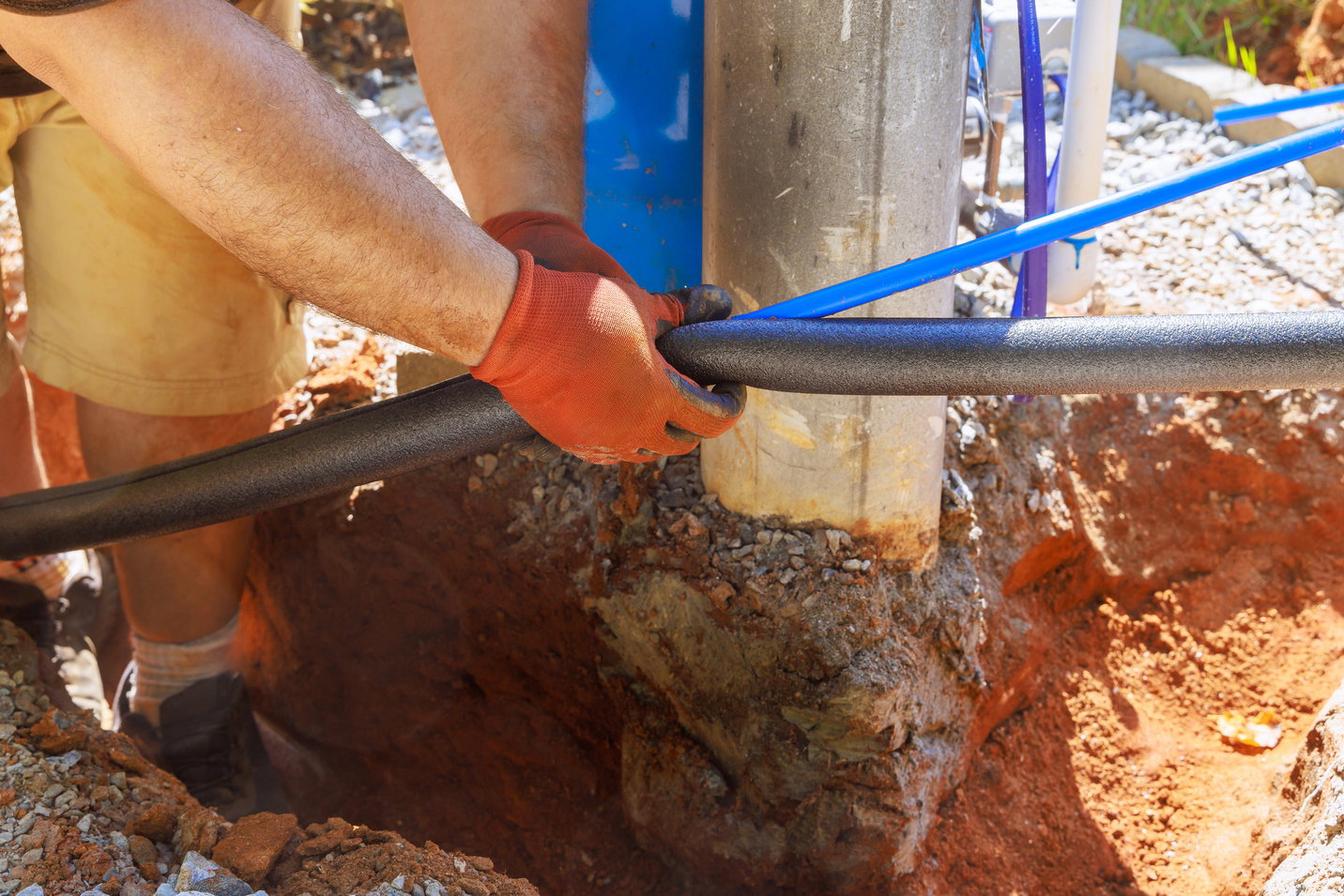
These provide enhanced flexibility and additional protection against mechanical impacts and moisture ingress, proving particularly beneficial in underground applications where the pipework needs to navigate uneven terrain or potential stresses from soil movement.
The widespread adoption of HDPE as a jacket material is a testament to its excellent balance of durability, chemical inertness, and resistance to environmental degradation, making it a reliable choice for safeguarding pre-insulated pipe systems in diverse operating conditions.
PVC is another material utilized for outer jackets, offering good strength and resistance to chemicals, often considered a more economical option for certain applications.
It can be used for both indoor and outdoor applications, with specific PVC formulations available that incorporate UV protection for external use.
While PVC provides a cost-effective and chemically resistant jacketing solution, HDPE is generally the preferred choice for buried systems and applications demanding superior long-term durability and UV resistance.
Steel, including various coated options, serves as a robust material for outer jackets, providing exceptional mechanical protection in demanding environments where pre-insulated pipes might be subjected to significant physical stress or impact.
Coated steel options, such as galvanized steel and stainless steel, offer enhanced resistance to corrosion, making them suitable for use in potentially corrosive environments.
Metal covers, including those made from steel and aluminium, are also used for above-ground applications where a high level of mechanical protection and durability is required.
Steel jackets are typically specified in applications where the pre-insulated pipework needs to withstand severe mechanical stresses or potential impacts, providing an additional layer of protection beyond that offered by polymer-based jackets.
The selection of appropriate materials for the carrier pipe, insulation, and outer jacket is a critical aspect of designing a pre-insulated pipework system that will perform efficiently and reliably over its intended lifespan.
Engineers must carefully consider the specific requirements of the application, the operating environment, and the relevant standards and regulations to ensure the optimal choice of materials for each component.
UK Manufacturers of Prelagged Pipework Systems
These companies offer integrated solutions where the carrier pipe, insulation, and outer casing are supplied as a single, finished product.
Durotan Ltd
Based in the UK, Durotan specialises in the supply and installation of preinsulated pipe systems. They offer both steel and flexible PEX-based preinsulated pipes, suitable for applications like district heating and cooling.
CPV Ltd
As a UK-based manufacturer with a long history, CPV offers a range of preinsulated pipe systems under their Hiline brand. These systems cater for various applications, including district heating and cooling networks, utilising different carrier pipe materials within their preinsulated assemblies.
Uponor
A significant supplier in the UK market, Uponor provides the Ecoflex range of flexible preinsulated pipe systems. These systems are commonly used for heat and water distribution, offering solutions for connecting buildings and for local networks.
Mibec
Mibec are suppliers of underground preinsulated pipework in the UK. They offer systems from manufacturers like REHAU and Microflex, as well as their own Mibec DHP range, providing options for various project sizes and applications, particularly in district heating.
Vital Energi
While also heavily involved in the installation of energy networks, Vital Energi supplies preinsulated pipes in the UK. They offer different types, including single steel pipes and flexible plastic pipe systems, for various temperature requirements.
BRUGG Pipes
Although an international manufacturer, BRUGG Pipes has a strong presence and supplies its preinsulated pipe systems, such as the CALPEX range, within the UK market. Their systems are known for their flexible design and high-performance insulation.
Best Practices for Installation: Ensuring Efficiency and Longevity
Proper installation is paramount to realizing the full benefits of pre-insulated pipework and ensuring its long-term efficiency and reliability.
Best practices vary depending on whether the installation is internal or external.
Internal Installations
When installing pre-insulated pipework within buildings, several key considerations must be addressed to ensure optimal performance and longevity.
Careful routing of the pipework is essential, taking into account any space constraints, structural elements, and the need for accessibility for future maintenance.
Flexible plastic pipes, such as those made from PEX or PP-R, offer a significant advantage in internal installations due to their ability to be easily bent around obstructions and navigated through tight spaces, thereby minimizing the number of required fittings and simplifying complex layouts.
Support and fixing methods play a crucial role in maintaining the integrity of the pipework.
Appropriate hangers, clamps, or other support systems should be used at regular intervals to prevent sagging and ensure the structural stability of the system.
It is particularly important to adequately anchor the pipework at system extremities, such as where pipes pass through walls or connect to equipment.
This secure anchoring is vital for effectively managing the thermal expansion and contraction forces that occur due to temperature fluctuations within the pipes, thereby preventing damage to both the pipes themselves and the connected components.
The selection of appropriate jointing techniques is critical and depends on the material of the carrier pipe.
For steel pipes, skilled welding techniques are necessary, ensuring that the pipe ends are thoroughly cleaned before welding and that the surrounding insulation and outer jacket are adequately protected from the heat and any welding spatter.
Copper pipes are typically joined using soldering or brazing methods, with care taken to ensure compatibility with the insulation material and to shield it from excessive heat during the joining process.
For plastic pipes such as PEX, PE-RT, and PP-R, various techniques are employed, including butt fusion or electrofusion welding for PP-R, and mechanical compression fittings or electrofusion fittings for PE and PEX.
These methods are often favoured for their ease and speed of installation compared to welding, and many do not require specialized tools.
Finally, it is important to provide protection against internal building factors.
This includes safeguarding pre-insulated pipework from potential damage that may occur during other construction activities within the building.
Care should be taken to avoid mechanical impacts, and proper sealing is essential where pipes pass through walls or floors to maintain the fire integrity of the building (referencing relevant standards like BS 5422 and Building Regulations Part B for fire safety).
Additionally, preventing the ingress of moisture or other contaminants into the insulation layer, particularly at joints and terminations, is crucial for maintaining the system's performance and preventing corrosion.
External Installations ![]()
Installing pre-insulated pipework in external environments presents its own set of best practices, primarily focusing on trench preparation, support systems, jointing procedures, and protection against environmental factors.
Proper trench preparation and bedding are fundamental for buried pre-insulated pipework.
This involves excavating trenches to the correct dimensions, taking into account the local frost line to determine the minimum depth at which the pipes should be laid.
Creating a level and stable bed, often using sand or fine gravel, is essential to support the pipes evenly and prevent damage from sharp objects or uneven settling of the ground.7
Any sharp objects must be removed from the trench, and the bedding material should be compacted to provide adequate support.
For larger pipes or areas that will experience heavy traffic loads, the depth of burial needs to be increased to provide sufficient protection.
Support systems are also critical for external pre-insulated pipework, both for sections that are above ground and for the points where buried pipes transition to above-ground.
For above-ground installations, supports should be selected that are compatible with the pre-insulated pipe and designed to minimize thermal bridging, which can lead to energy losses.
For buried pipes, proper bedding and backfilling are essential to provide adequate support and protect against the weight of the soil and any ground movement.
In colder climates, for systems operating at low temperatures, the use of multiple insulation layers in pipe supports is recommended to improve the moisture seal and prevent potential issues like condensation and freezing.
Jointing procedures for external pre-insulated pipework require careful attention, considering the different conditions encountered above and below ground.
For steel carrier pipes, high-quality welding in accordance with relevant standards is crucial, followed by the proper insulation and sealing of the joint to maintain the integrity of the pre-insulated system.
Heat-shrink sleeves and other specialized jointing kits are commonly used for sealing joints in both steel and plastic pipe systems, particularly for underground applications.
These ensure a watertight seal, preventing moisture from entering the insulation layer and potentially causing damage.
For plastic carrier pipes, electrofusion and mechanical fittings are widely used.
It is essential to follow the manufacturer's instructions meticulously during installation to ensure proper sealing, especially in buried environments where the consequences of leaks or moisture ingress can be significant.
Protecting external pre-insulated pipework against environmental factors is crucial for its long-term performance.
Moisture is a major concern, and the use of watertight outer jackets made from materials like HDPE or PVC, along with properly sealed joints, is essential to prevent water from entering the system and damaging the insulation or corroding the carrier pipe.
For outdoor sections exposed to sunlight, using UV-resistant materials like black HDPE for the outer jacket is important to prevent degradation of the jacket and maintain the insulation's integrity over time.
In buried applications, selecting flexible pipe materials, particularly plastics, is crucial to accommodate potential ground movement without causing stress or damage to the pipe system.
Proper bedding and backfilling are also essential to minimize stress on the pipes from soil loads.
Finally, the insulation material and thickness should be carefully chosen to suit the expected temperature range, preventing freezing in cold climates and minimizing heat gain in hot climates.
Buy pre Insulated Pipes
Navigating the Rules: Standards and Regulations in the UK
The design, installation, and performance of pre-insulated pipework in the UK are governed by a comprehensive set of standards and regulations aimed at ensuring safety, efficiency, and environmental protection.
British Standards (BS)
The BS EN 15632 series is particularly relevant for pre-insulated flexible pipe systems used in district heating networks.
This series comprises several parts, each addressing specific aspects: Part 1 covers classification, general requirements, and test methods; Part 2 focuses on bonded plastic service pipes; Part 3 deals with non-bonded systems using plastic service pipes; and Part 4 specifies requirements for bonded systems with metal service pipes.
For polymer pipes used in district heating networks, these standards mandate a minimum lifespan of 30 years under specified operating conditions, typically at a temperature of 80°C.
BS 5422 provides the methodology for specifying thermal insulating materials on pipes, tanks, vessels, ductwork, and equipment operating within a broad temperature range.
The standard was updated in 2023 and now incorporates the Euroclass system for classifying the reaction to fire of insulation materials.
It also establishes minimum performance levels for different operating conditions and building types, distinguishing between dwelling and non-dwelling applications.
BS 5422 is a cornerstone standard for determining the appropriate insulation thicknesses required to comply with energy efficiency regulations.
Other pertinent British Standards include BS EN 253, which sets out the general requirements for district heating pipes ; BS EN 448 for pre-insulated pipe systems using steel casing pipes; BS EN 488 for steel valves used in district heating and cooling; and BS EN 489 for joint systems used in buried pipe networks for district heating and cooling, specifying requirements and tests.
Additionally, BS 5970 offers a code of practice for the thermal insulation of pipework and equipment, and BS 6700 provides specifications for the design, installation, testing, and maintenance of services supplying water.
UK Building Regulations
Part L of the UK Building Regulations, which focuses on the conservation of fuel and power, sets the minimum energy efficiency standards for pipe insulation in both new and existing buildings.
These regulations require the insulation of primary hot water and heating pipes in unheated spaces and within building voids to minimize heat loss.
Guidance on the specific insulation thicknesses and performance levels required is often derived from BS 5422.
Furthermore, adherence to fire safety regulations, primarily outlined in Part B of the Building Regulations, is crucial.
These regulations stipulate that any insulated pipework used inside a building must meet specified fire performance criteria.
There is an increasing focus on the fire safety aspects of pre-insulated polyethylene pipework, emphasizing the need for products to comply with relevant fire performance specifications and the Euroclass ratings system.
Water Regulations Advisory Scheme (WRAS)
For pre-insulated pipework intended for use in potable water systems within the UK, compliance with the Water Regulations Advisory Scheme (WRAS) is mandatory.
WRAS approval serves as confirmation that the materials used in the pipes and fittings do not contaminate the water supply and meet the necessary standards for safety and performance, thereby ensuring compliance with the Water Fittings Regulations.
Renewable Heat Incentive (RHI) and Microgeneration Certification Scheme (MCS)
The Renewable Heat Incentive (RHI) scheme, designed to encourage the use of renewable heating technologies, has specific implications for pre-insulated pipework.
For the Non-Domestic RHI, the guidelines state that pre-insulated pipes connecting the renewable heat source to the buildings must be "properly insulated," a requirement often interpreted as meeting the standards set forth in EN 15632.
While the Domestic RHI does not explicitly detail specific pipe insulation standards, the overall efficiency of the heating system, to which pre-insulated pipes significantly contribute, is a key factor.
Additionally, for many renewable heating technologies to be eligible for RHI payments, certification under the Microgeneration Certification Scheme (MCS) is a prerequisite.
Navigating the UK's regulatory landscape for pre-insulated pipework demands a thorough understanding of British Standards, Building Regulations (particularly Part L and fire safety), WRAS compliance for potable water applications, and the specific requirements associated with renewable energy incentive schemes like RHI and MCS.
Adherence to these standards and regulations is not only essential for ensuring the safety and efficiency of pre-insulated pipework systems but also for achieving compliance with legal requirements and potentially accessing financial incentives.
The increasing emphasis on fire safety in buildings and the drive towards greater energy efficiency underscore the critical importance of selecting and installing pre-insulated pipework that meets the latest regulatory demands.
The Case for Pre-Insulated: Benefits Over Traditional Methods ![]()
Pre-insulated pipework offers a compelling array of advantages over traditional methods of pipe insulation, making it an increasingly preferred choice for a wide range of applications.
Superior Energy Efficiency and Reduced Thermal Losses
The integrated insulation in pre-insulated pipes provides significantly better thermal performance compared to traditional methods where insulation is applied as a separate layer on site.
This results in a substantial reduction in heat loss or gain during fluid transport, leading to lower energy consumption and improved overall system efficiency.
Studies indicate that pre-insulated pipes can reduce heat or cooling losses by as much as 90% compared to uninsulated pipes.
The insulation materials used in pre-insulated pipes often exhibit lower lambda values (thermal conductivity) compared to traditional insulation methods like mineral wool with a metal casing, indicating a higher level of thermal resistance.
This superior insulation capability ensures that the fluid being transported maintains a more consistent temperature over longer distances, reducing the need for energy-intensive reheating or recooling in applications such as district heating networks and industrial processes.
Faster and Easier Installation, Leading to Reduced Labour Costs
Pre-insulated pipes are supplied with the insulation already in place, which significantly speeds up the installation process by eliminating the need for a separate insulation step on site.
This pre-fabrication leads to reduced labour costs and a faster overall project completion time.
Being prefabricated systems, they are also generally easier to transport and handle on site.
The availability of flexible pre-insulated pipes offers the additional benefit of requiring fewer joints and the ability to navigate around obstacles with greater ease, further simplifying the installation process and reducing both time and material costs.
Unlike traditional methods, there is no requirement for supplementary insulation to be applied on site to achieve the desired thermal performance.
Long-Term Cost Savings through Lower Energy Consumption and Maintenance
The initial investment in pre-insulated pipework often translates into significant long-term cost savings.
The superior energy efficiency of these systems leads to reduced energy bills due to the minimization of heat loss or gain.
This also results in lower overall operating costs associated with maintaining the desired fluid temperatures within the system.
Furthermore, the enhanced durability and resistance to corrosion, abrasion, and mechanical damage inherent in pre-insulated pipework contribute to reduced maintenance and repair costs over the system's lifespan.
The extended service life of pre-insulated pipes also means that replacements are required less frequently, leading to further long-term cost savings.
Enhanced Durability and Extended System Lifespan
Pre-insulated pipes are designed and constructed to be highly durable, offering excellent resistance to corrosion, environmental degradation, and physical damage.
The protective outer jacket plays a crucial role in shielding the insulation and carrier pipe from these detrimental factors, leading to a significantly extended lifespan compared to traditional insulation methods.
In systems where a watertight jacket is used, the carrier pipes are kept dry, preventing corrosion from occurring.
Many pre-insulated pipe systems are designed for a long service life, often exceeding 25 to 30 years, with some specifically engineered to last for 50 years or even longer.
Improved System Integrity and Reduced Risk of Corrosion
Pre-insulated pipe systems are often manufactured under factory-controlled conditions, which ensures a consistent level of insulation quality and reduces the potential for on-site installation errors that can occur with traditional insulation methods.
The use of watertight outer jackets in many pre-insulated systems effectively prevents moisture from penetrating the insulation layer, a key factor in reducing the risk of corrosion and maintaining the insulation's thermal performance over time.
Furthermore, if the carrier pipe itself is made from a corrosion-resistant material such as plastic (e.g., PEX, PP-R) or stainless steel, the overall system integrity is significantly enhanced, and the risk of internal corrosion is minimized.
Applications in the UK: Where Pre Insulated Pipework Excels
Pre-insulated pipework has found widespread application across various sectors in the UK, demonstrating its versatility and effectiveness in a multitude of fluid transport scenarios.
District Heating and Cooling Networks
Pre-insulated pipework is extensively used in the UK for district heating schemes, which involve the efficient distribution of hot water from a centralized energy source to multiple properties, including residential, commercial, and multi-occupancy buildings.
These underground networks, often referred to as heat mains, consist of pre-insulated pipes that connect the central heat source to individual buildings.
The heat source can vary, including traditional fossil fuels, energy derived from waste, industrial waste heat, and increasingly, renewable energy sources such as heat pumps and biomass boilers.
Within each connected building, heat interface units (HIUs) utilize the hot water from the district network to provide heating and domestic hot water, allowing for individual temperature control for each user.
Pre-insulated pipework is also crucial for district cooling systems in the UK, enabling the efficient distribution of chilled water for air conditioning purposes in urban environments and large commercial complexes.
Industrial Processes
In the UK's industrial sector, pre-insulated pipework plays a vital role in transporting fluids at precisely controlled temperatures, a necessity for a wide range of processes.
These applications span chemical plants, food processing units, pharmaceutical manufacturing facilities, and various other industrial settings.
The fluids transported through these systems can include drinking water, wastewater, cooling water, hot water, steam, hydrocarbons, condensate, various chemicals, lye, and oil, each requiring specific temperature maintenance for process efficiency and safety.
Pre-insulated pipes are also employed in cryogenic applications within the UK, facilitating the safe and efficient transport of liquefied natural gas (LNG) at extremely low temperatures.
Domestic Hot and Cold Water Distribution
Pre-insulated pipework is increasingly utilized in residential and commercial buildings across the UK for the efficient distribution of both hot and cold water.
In hot water systems, the insulation helps to maintain the water temperature as it travels from the heat source to the point of use, reducing energy consumption by minimizing heat loss and negating the need for frequent reheating.
Similarly, in cold water systems, pre-insulated pipes help to protect the water from freezing, particularly in exposed locations or when pipes are laid underground, and can also help maintain the water's coolness.
Renewable Energy Systems
Pre-insulated pipework plays a crucial role in the effective integration of renewable energy systems in the UK.
It is commonly used to connect heat pumps (both ground source and air source), biomass boilers, and solar thermal collectors to heating and hot water systems.
The efficient transport of heat from these sources to the point of use is paramount for maximizing system performance and the financial benefits offered by schemes like the Renewable Heat Incentive (RHI).
Other Applications
Beyond these major areas, pre-insulated pipework finds application in a variety of other sectors within the UK, including HVAC systems in commercial and residential buildings, refrigeration products and systems, agricultural applications such as irrigation and livestock watering, infrastructure projects like tunnels and bridges, marine and offshore environments, water and wastewater treatment facilities, geothermal power plants, temporary water supply lines for freeze protection, shallow-bury installations for municipal water service lines, and even in specialized industrial settings like mining operations.
Industry Concerns About Flammable Polyethylene Pre-insulated Pipes
The UK building services industry has raised significant alarm regarding the fire safety risks associated with polyethylene (PE) pre-insulated pipework, particularly when used in inappropriate applications. In 2022, leading trade associations including the Building Engineering Services Association (BESA), the Thermal Insulation Contractors Association (TICA), and the British Plastics Federation (BPF) issued joint warnings about these systems.
The primary concern centres on the increasingly common practice of installing pre-insulated pipework designed for underground applications inside buildings. This represents what industry experts call a "fundamental change in product application" that potentially breaches UK Building Regulations. Pre-insulated pipework systems typically incorporate PE insulants that do not meet the fire performance criteria specified for internal building applications.
Of particular concern is the use of coiled flexible polyethylene insulated piping systems in high-risk settings such as large multi-residential buildings. BESA's head of technical, Graeme Fox, described this as "a critical fire safety issue," emphasising that these products may have been tested and certified, but not necessarily for the particular application in question.
The warnings highlight that the "one-size-fits-all approach to insulation thickness" by manufacturers of pre-insulated pipework fails to provide the flexibility needed to meet individual specification requirements. Industry bodies have urged specifiers to verify that each product has the appropriate Euroclass fire rating and to request evidence of how the PE system would meet the heat loss/gain requirements of BS 5422 and Part L of the Building Regulations.
When pre-insulated pipes transition from outside to inside a building, it is "absolutely essential" that they are properly protected from damage and terminated correctly to "contain the insulation and retain the fire integrity of the outer sheath". Installers are advised to seek specialist fire-stopping advice and ensure all fire-stopping products have been fully tested and third-party certified where relevant.
The joint industry statement serves as a reminder that manufacturers, distributors, and installers of pre-insulated polyethylene pipework systems have a responsibility to provide evidence of the suitability of these products for specific applications, particularly in light of lessons learned from the Grenfell tragedy about the importance of appropriate product application.
Looking to the Future: Lifespan and Maintenance
The expected lifespan of pre-insulated pipework systems is a significant factor in their overall cost-effectiveness.
Several factors can influence this lifespan, including the quality of the materials used for the carrier pipe, insulation, and outer jacket.
Proper installation techniques, encompassing jointing and support, are also critical.
The operating conditions, such as temperature and pressure, to which the pipes are subjected play a vital role.
External environmental factors, including soil conditions, moisture levels, UV exposure for above-ground installations, and potential chemical loading, can also impact the longevity of the system.
The quality of the foam insulation itself and the method by which it is applied can significantly affect the life expectancy of underground pre-insulated pipe systems.
In closed systems, such as those used for district heating, the use of treated water is important.
Finally, the presence of a diffusion barrier within the pipe structure can help to prolong the lifespan by preventing the degradation of the insulation.
To ensure the continued efficiency and longevity of pre-insulated pipework systems, both internal and external, regular maintenance practices are essential.
These include conducting regular visual inspections to check for any signs of wear, damage, or compromised insulation.
Special attention should be paid to checking for leaks, particularly at joints.
The integrity of the outer jacket should be regularly assessed, and any damage should be repaired promptly to prevent moisture ingress.
Keeping the pipes clean and free of any debris is also important.
For underground systems, it is advisable to monitor for any potential ground movement or external loads that could affect the pipes.
In systems that are part of a Renewable Heat Incentive (RHI) scheme, periodic recalibration of the payment meters is a requirement.
Several potential issues can arise with pre-insulated pipework, and preventative measures can help to mitigate these risks.
Moisture ingress into the insulation is a significant concern as it can lead to mold growth, corrosion of the carrier pipe, and a reduction in insulation efficiency.
Ensuring proper sealing during installation and repair is crucial.
Damage to the outer jacket can compromise the insulation and allow water to enter the system, so careful handling of pipes during transport and installation is essential.
Thermal bridging at pipe supports can lead to heat loss or gain, so the use of pre-insulated supports is recommended.
Incorrect pipe sizing or improper installation can result in pressure losses and inefficient system operation.
For external installations, the use of black PE jackets is crucial for preventing UV degradation, which can affect non-UV resistant jacket materials.
While pre-insulated pipework generally offers a long lifespan and requires less maintenance compared to traditional insulation methods, adherence to proper installation techniques and the implementation of periodic inspections are vital to ensure continued efficiency and to proactively address any potential issues such as moisture ingress, damage to the outer jacket, or thermal bridging.
Understanding the factors that can affect the lifespan of these systems allows for the implementation of preventative maintenance measures, ultimately leading to extended system performance and longevity.
Conclusion: Investing in Efficiency and Sustainability
In conclusion, pre-insulated pipework presents a multitude of compelling advantages for both internal and external applications within the UK's building services and infrastructure sectors.
Its enhanced energy efficiency, achieved through superior insulation, leads to significant reductions in operational costs and a lower environmental impact.
The faster and easier installation processes associated with pre-insulated pipes translate to reduced labour costs and quicker project completion times.
Over the long term, the durability and extended lifespan of these systems result in substantial cost savings through decreased maintenance requirements and less frequent replacements.
The versatility of pre-insulated pipework is evident in its wide range of applications, from district heating and cooling networks that serve entire communities to the precise temperature control required in industrial processes, the efficient distribution of domestic hot and cold water, and the integration of renewable energy sources.
The critical role of pre-insulated pipework in achieving energy efficiency targets and promoting sustainable building practices within the UK construction sector cannot be overstated.
As the UK continues its transition towards a more sustainable future and strives to meet ambitious carbon reduction targets, investing in pre-insulated pipework represents a key strategic decision for a more efficient and environmentally responsible built environment.

Samuel Hitch
Managing Director
Buy Insulation Online.
Leave A Reply
Your feedback is greatly appreciated, please comment on our content below. Your email address will not be published. Required fields are marked *

